Hoffman D.M., Singh B., Thomas J.H. (Eds). Handbook of Vacuum Science and Technology
Подождите немного. Документ загружается.

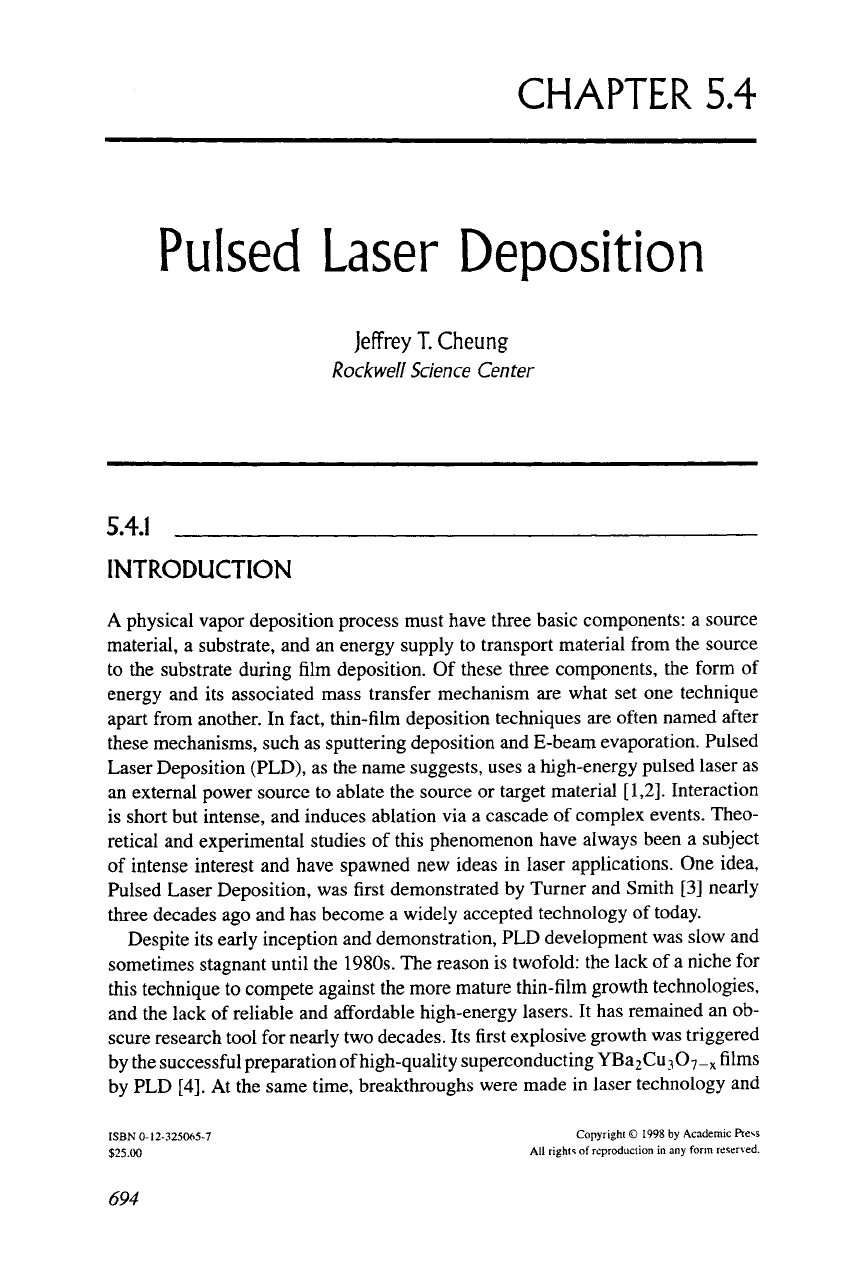
CHAPTER 5.4
Pulsed Laser Deposition
Jeffrey T. Cheung
Rockwell
Science
Center
5.4.1
INTRODUCTION
A physical vapor deposition process must have three basic components: a source
material, a substrate, and an energy supply to transport material from the source
to the substrate during film deposition. Of these three components, the form of
energy and its associated mass transfer mechanism are what set one technique
apart from another. In fact, thin-film deposition techniques are often named after
these mechanisms, such as sputtering deposition and E-beam evaporation. Pulsed
Laser Deposition (PLD), as the name suggests, uses a high-energy pulsed laser as
an external power source to ablate the source or target material
[1,2].
Interaction
is short but intense, and induces ablation via a cascade of complex events. Theo-
retical and experimental studies of this phenomenon have always been a subject
of intense interest and have spawned new ideas in laser applications. One idea,
Pulsed Laser Deposition, was first demonstrated by Turner and Smith [3] nearly
three decades ago and has become a widely accepted technology of today.
Despite its early inception and demonstration, PLD development was slow and
sometimes stagnant until the 1980s. The reason is twofold: the lack of a niche for
this technique to compete against the more mature thin-film growth technologies,
and the lack of reliable and affordable high-energy lasers. It has remained an ob-
scure research tool for nearly two decades. Its first explosive growth was triggered
by the successful preparation of high-quality superconducting YBa2Cu307_x films
by PLD [4]. At the same time, breakthroughs were made in laser technology and
ISBN 0-12-325065-7 Copyright © 1998 by Academic Press
$25.00 AH rights of reproduction in any form reserved.
694
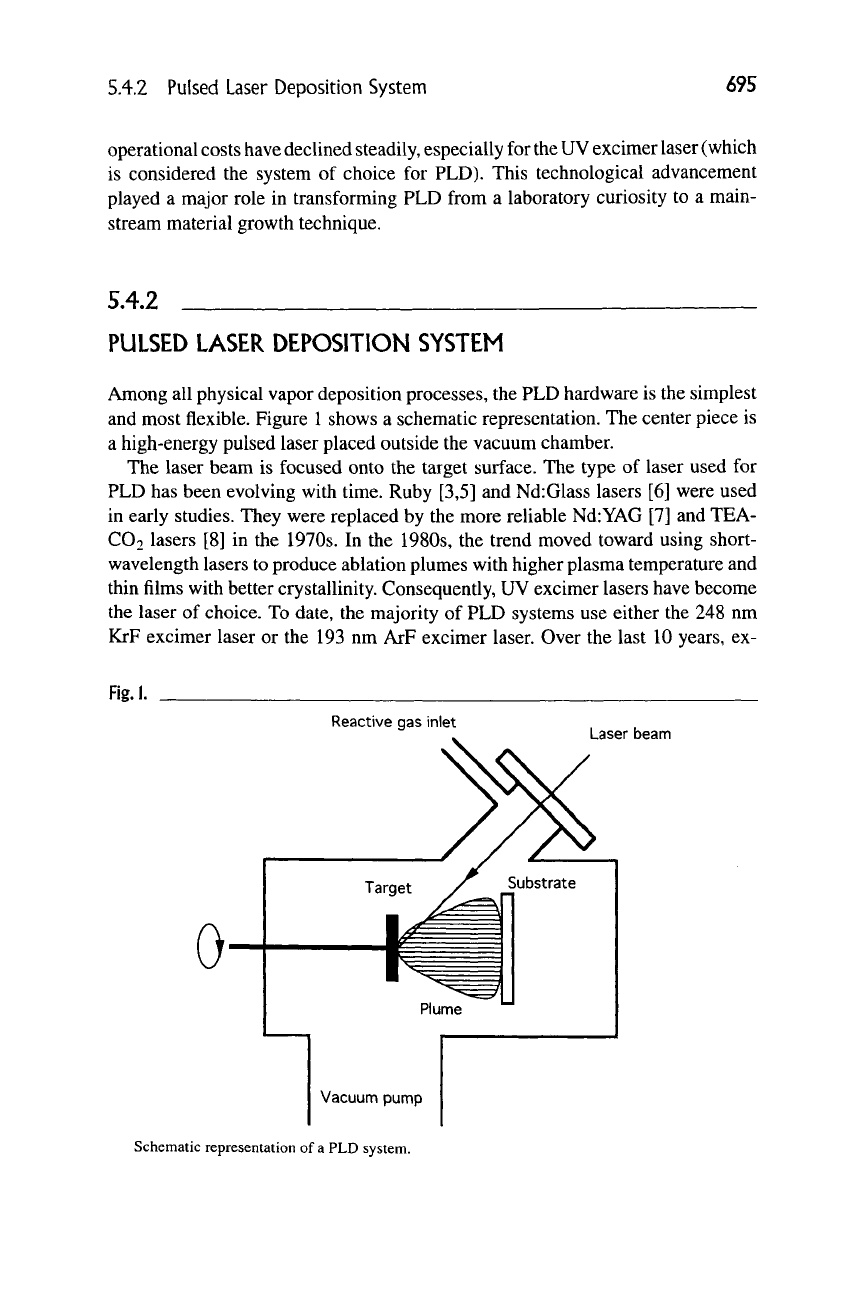
5.4.2 Pulsed Laser Deposition System
695
operational costs have declined steadily, especially for
the
UV excimer laser (which
is considered the system of choice for PLD). This technological advancement
played a major role in transforming PLD from a laboratory curiosity to a main-
stream material growth technique.
5.4.2
PULSED LASER DEPOSITION SYSTEM
Among all physical vapor deposition processes, the PLD hardware is the simplest
and most flexible. Figure
1
shows a schematic representation. The center piece is
a high-energy pulsed laser placed outside the vacuum chamber.
The laser beam is focused onto the target surface. The type of laser used for
PLD has been evolving with time. Ruby [3,5] and Nd:Glass lasers [6] were used
in early studies. They were replaced by the more reliable NdiYAG [7] and TEA-
CO2 lasers [8] in the 1970s. In the 1980s, the trend moved toward using short-
wavelength lasers to produce ablation plumes with higher plasma temperature and
thin films with better crystallinity. Consequently, UV excimer lasers have become
the laser of choice. To date, the majority of PLD systems use either the 248 nm
KrF excimer laser or the 193 nm ArF excimer laser. Over the last 10 years, ex-
Fig.
I.
Reactive gas inlet
Laser beam
Vacuum pump
Schematic representation of
a
PLD system.
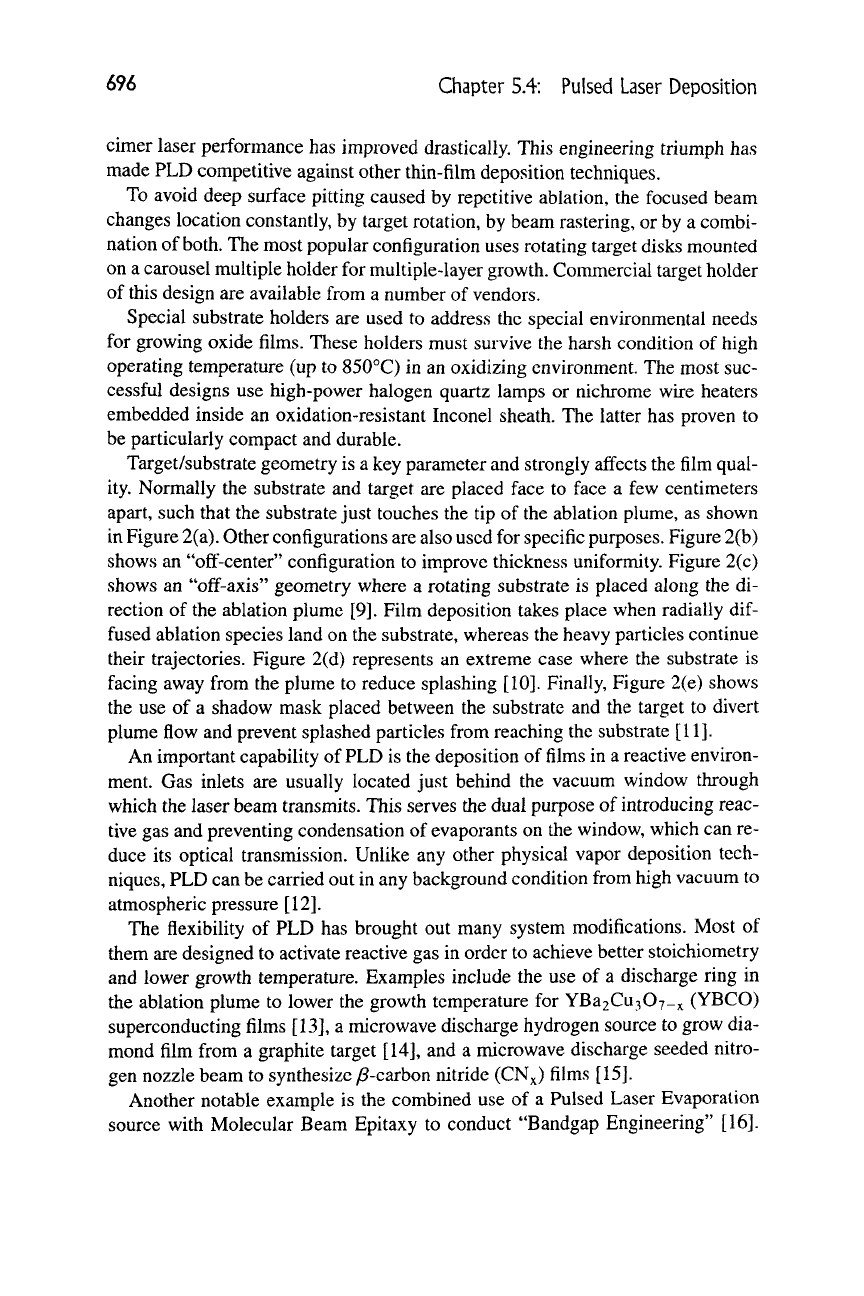
696 Chapter
5.4:
Pulsed Laser Deposition
cimer laser performance has improved drastically. This engineering triumph has
made PLD competitive against other thin-film deposition techniques.
To avoid deep surface pitting caused by repetitive ablation, the focused beam
changes location constantly, by target rotation, by beam rastering, or by a combi-
nation of both. The most popular configuration uses rotating taiget disks mounted
on a carousel multiple holder for multiple-layer growth. Commercial target holder
of this design are available from a number of vendors.
Special substrate holders are used to address the special environmental needs
for growing oxide films. These holders must survive the harsh condition of high
operating temperature (up to 850°C) in an oxidizing environment. The most suc-
cessful designs use high-power halogen quartz lamps or nichrome wire heaters
embedded inside an oxidation-resistant Inconel sheath. The latter has proven to
be particularly compact and durable.
Target/substrate geometry is a key parameter and strongly affects the film qual-
ity. Normally the substrate and target are placed face to face a few centimeters
apart, such that the substrate just touches the tip of the ablation plume, as shown
in Figure
2(a).
Other configurations are also used for specific purposes. Figure 2(b)
shows an "off-center" configuration to improve thickness uniformity. Figure 2(c)
shows an "off-axis" geometry where a rotating substrate is placed along the di-
rection of the ablation plume [9]. Film deposition takes place when radially
dif-
fused ablation species land on the substrate, whereas the heavy particles continue
their trajectories. Figure 2(d) represents an extreme case where the substrate is
facing away from the plume to reduce splashing [10]. Finally, Figure 2(e) shows
the use of a shadow mask placed between the substrate and the target to divert
plume flow and prevent splashed particles from reaching the substrate [11].
An important capability of PLD is the deposition of films in a reactive environ-
ment. Gas inlets are usually located just behind the vacuum window through
which the laser beam transmits. This serves the dual purpose of introducing reac-
tive gas and preventing condensation of evaporants on the window, which can re-
duce its optical transmission. Unlike any other physical vapor deposition tech-
niques, PLD can be carried out in any background condition from high vacuum to
atmospheric pressure [12].
The flexibility of PLD has brought out many system modifications. Most of
them are designed to activate reactive gas in order to achieve better stoichiometry
and lower growth temperature. Examples include the use of a discharge ring in
the ablation plume to lower the growth temperature for YBa2Cu307_x (YBCO)
superconducting films [13], a microwave discharge hydrogen source to grow dia-
mond film from a graphite target [14], and a microwave discharge seeded nitro-
gen nozzle beam to synthesize yS-carbon nitride (CNx) films [15].
Another notable example is the combined use of a Pulsed Laser Evaporation
source with Molecular Beam Epitaxy to conduct "Bandgap Engineering" [16].
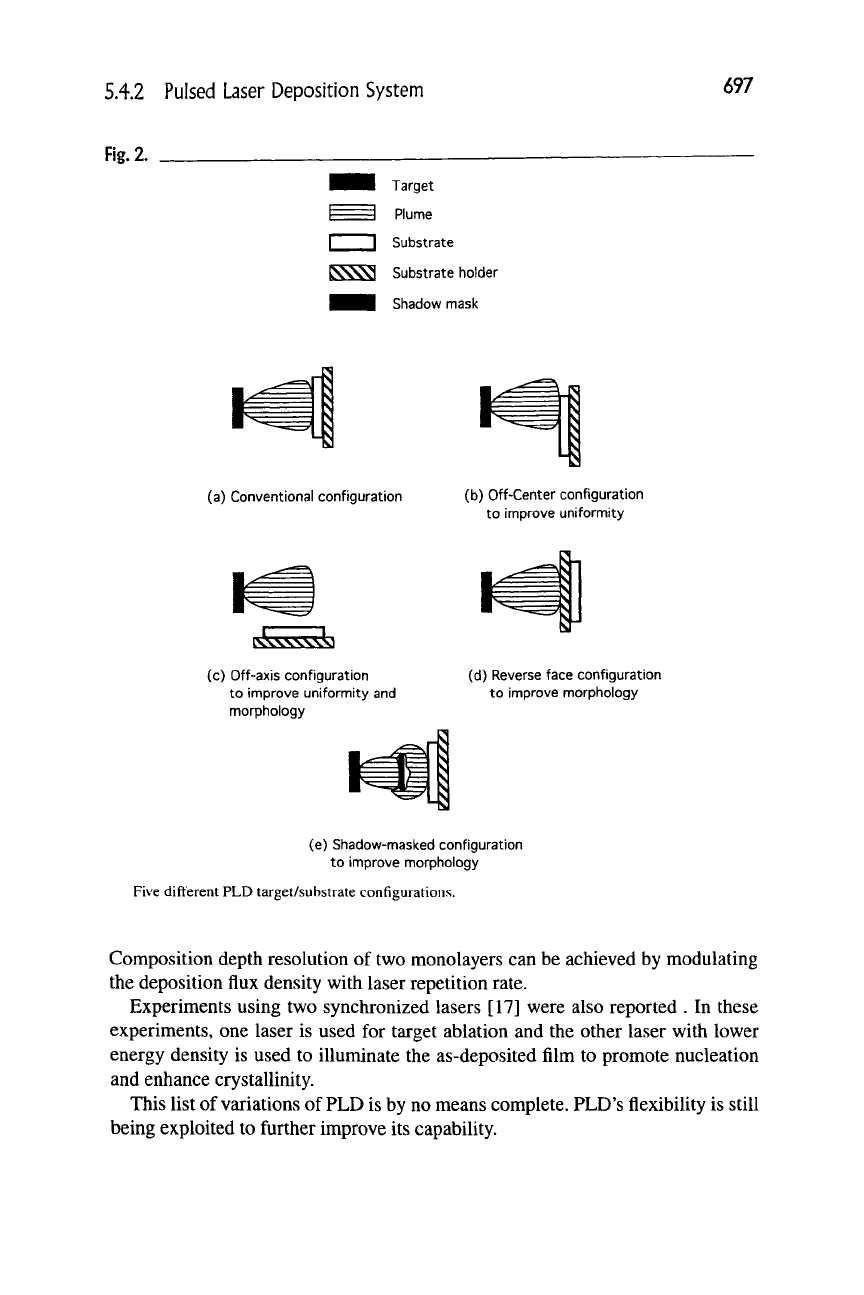
5.4.2 Pulsed Laser Deposition System
697
Rg.2.
HH Target
1 I Plume
Substrate
I>^^^
Substrate holder
HHI Shadow mask
(a) Conventional configuration
(b) Off-Center configuration
to improve uniformity
L\\V\\\\M
(c) Off-axis configuration
to improve uniformity and
morphology
(d) Reverse face configuration
to improve morphology
(e) Shadow-masked configuration
to improve morphology
Five difterent PLD target/substrate configurations.
Composition depth resolution of two monolayers can be achieved by modulating
the deposition flux density with laser repetition rate.
Experiments using two synchronized lasers [17] were also reported . In these
experiments, one laser is used for target ablation and the other laser with lower
energy density is used to illuminate the as-deposited film to promote nucleation
and enhance crystallinity.
This list of variations of PLD is by no means complete. PLD's flexibility is still
being exploited to further improve its capability.
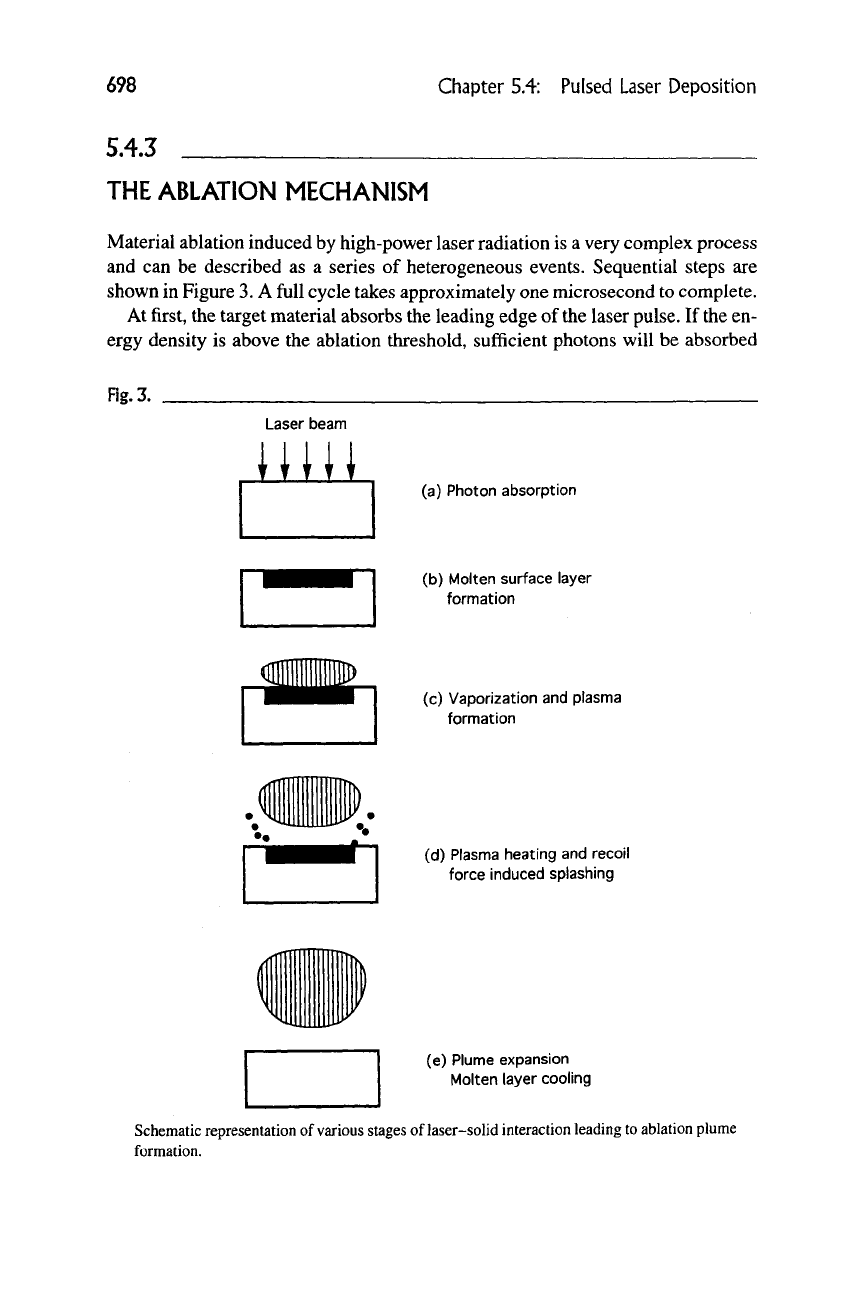
698
Chapter 5.4: Pulsed Laser Deposition
5.4.3
THE ABLATION MECHANISM
Material ablation induced by high-power laser radiation is a very complex process
and can be described as a series of heterogeneous events. Sequential steps are
shown in Figure
3.
A full cycle takes approximately one microsecond to complete.
At first, the target material absorbs the leading edge of the laser
pulse.
If the en-
ergy density is above the ablation threshold, sufficient photons will be absorbed
Rg.3.
Laser beam
(a) Photon absorption
(b) Molten surface layer
formation
(c) Vaporization and plasma
formation
(d) Plasma heating and recoil
force induced splashing
(e) Plume expansion
Molten layer cooling
Schematic representation of
various
stages of laser-solid interaction leading to ablation plume
formation.
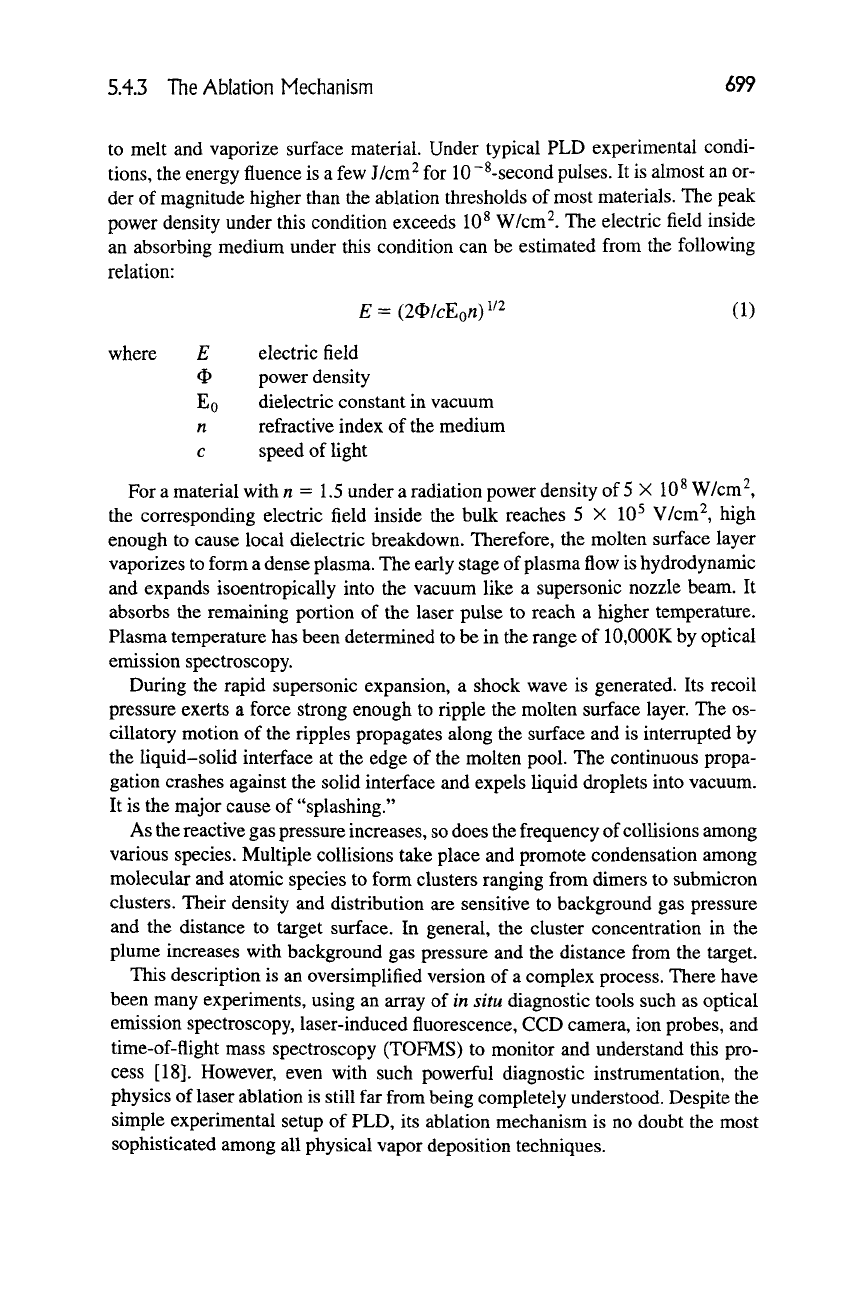
5.4.3 The Ablation Mechanism 699
to melt and vaporize surface material. Under typical PLD experimental condi-
tions,
the energy fluence is a few J/cm^ for
10
"^-second pulses. It is almost an or-
der of magnitude higher than the ablation thresholds of most materials. The peak
power density under this condition exceeds 10^ W/cm^. The electric field inside
an absorbing medium under this condition can be estimated from the following
relation:
£ = (24)/cEoAi)^^^ (1)
where E electric field
<E>
power density
EQ
dielectric constant in vacuum
n refractive index of the medium
c speed of light
For a material with n =
1,5
under a radiation power density of
5
X 10
^
W/cm ^,
the corresponding electric field inside the bulk reaches 5 X 10^ V/cm^, high
enough to cause local dielectric breakdown. Therefore, the molten surface layer
vaporizes to form a dense plasma. The early stage of plasma flow is hydrodynamic
and expands isoentropically into the vacuum like a supersonic nozzle beam. It
absorbs the remaining portion of the laser pulse to reach a higher temperature.
Plasma temperature has been determined to be in the range of 10,000K by optical
emission spectroscopy.
During the rapid supersonic expansion, a shock wave is generated. Its recoil
pressure exerts a force strong enough to ripple the molten surface layer. The os-
cillatory motion of the ripples propagates along the surface and is interrupted by
the liquid-solid interface at the edge of the molten pool. The continuous propa-
gation crashes against the solid interface and expels liquid droplets into vacuum.
It is the major cause of "splashing."
As the reactive gas pressure increases,
so
does the frequency of collisions among
various species. Multiple collisions take place and promote condensation among
molecular and atomic species to form clusters ranging from dimers to submicron
clusters. Their density and distribution are sensitive to background gas pressure
and the distance to target surface. In general, the cluster concentration in the
plume increases with background gas pressure and the distance from the target.
This description is an oversimplified version of a complex process. There have
been many experiments, using an array of in situ diagnostic tools such as optical
emission spectroscopy, laser-induced fluorescence, CCD camera, ion probes, and
time-of-flight mass spectroscopy (TOFMS) to monitor and understand this pro-
cess [18]. However, even with such powerful diagnostic instrumentation, the
physics of laser ablation is still far from being completely understood. Despite the
simple experimental setup of PLD, its ablation mechanism is no doubt the most
sophisticated among all physical vapor deposition techniques.
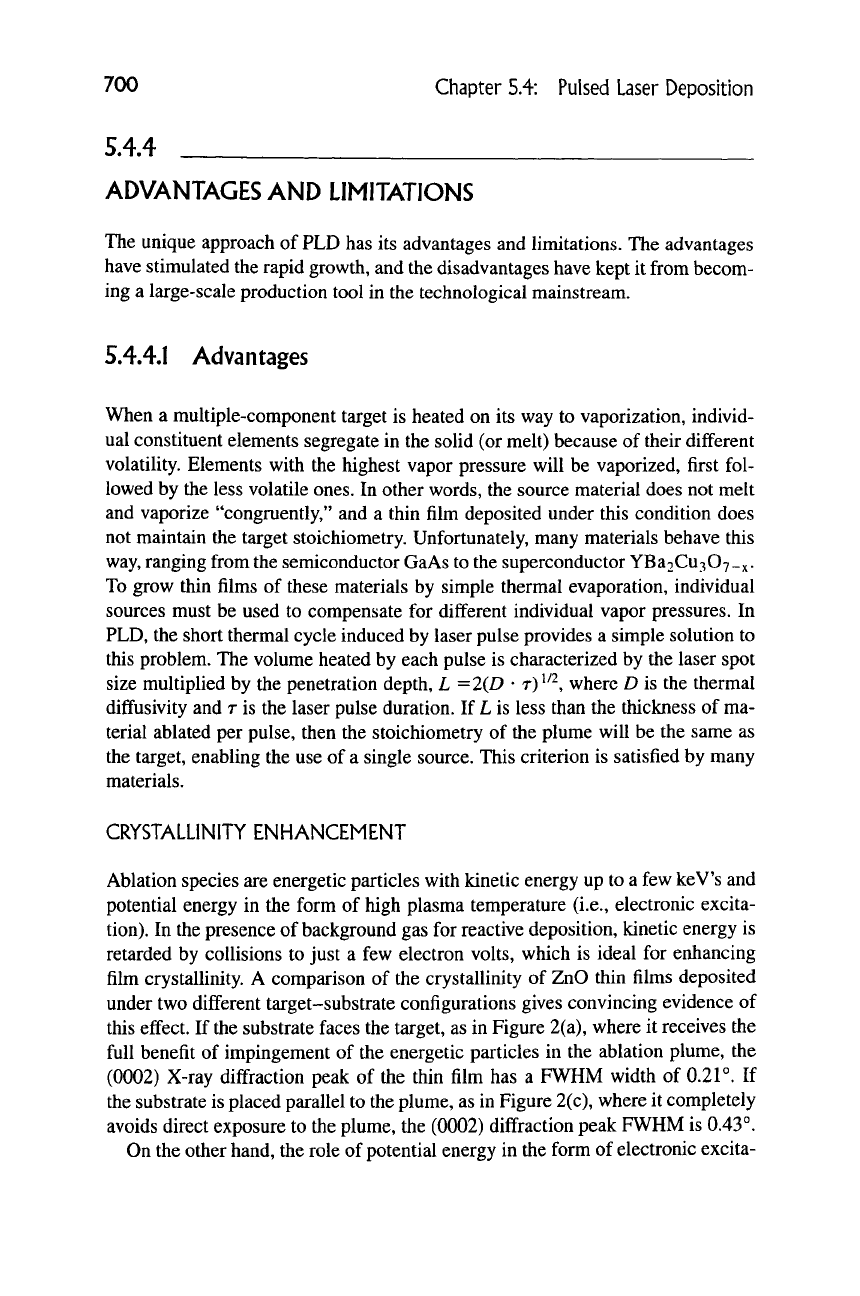
700 Chapter 5.4: Pulsed Laser Deposition
5.4.4
ADVANTAGES AND LIMITATIONS
The unique approach of PLD has its advantages and limitations. The advantages
have stimulated the rapid growth, and the disadvantages have kept it from becom-
ing a large-scale production tool in the technological mainstream.
5.4.4.1 Advantages
When a multiple-component target is heated on its way to vaporization, individ-
ual constituent elements segregate in the solid (or melt) because of their different
volatility. Elements with the highest vapor pressure will be vaporized, first fol-
lowed by the less volatile ones. In other words, the source material does not melt
and vaporize "congruently," and a thin film deposited under this condition does
not maintain the target stoichiometry. Unfortunately, many materials behave this
way, ranging from the semiconductor GaAs to the superconductor YBa2Cu307_x.
To grow thin films of these materials by simple thermal evaporation, individual
sources must be used to compensate for different individual vapor pressures. In
PLD,
the short thermal cycle induced by laser pulse provides a simple solution to
this problem. The volume heated by each pulse is characterized by the laser spot
size multiplied by the penetration depth, L =2(D • r)
^''^,
where D is the thermal
dififusivity and r is the laser pulse duration. If L is less than the thickness of ma-
terial ablated per pulse, then the stoichiometry of the plume will be the same as
the target, enabling the use of a single source. This criterion is satisfied by many
materials.
CRYSTALLINITY ENHANCEMENT
Ablation species are energetic particles with kinetic energy up to a few keV's and
potential energy in the form of high plasma temperature (i.e., electronic excita-
tion).
In the presence of background gas for reactive deposition, kinetic energy is
retarded by collisions to just a few electron volts, which is ideal for enhancing
film crystallinity. A comparison of the crystallinity of ZnO thin films deposited
under two different target-substrate configurations gives convincing evidence of
this effect. If the substrate faces the target, as in Figure 2(a), where it receives the
full benefit of impingement of the energetic particles in the ablation plume, the
(0002) X-ray diffraction peak of the thin film has a FWHM width of 0.21°. If
the substrate is placed parallel to the plume, as in Figure 2(c), where it completely
avoids direct exposure to the plume, the (0002) diffraction peak FWHM is 0.43°.
On the other hand, the role of potential energy in the form of electronic excita-
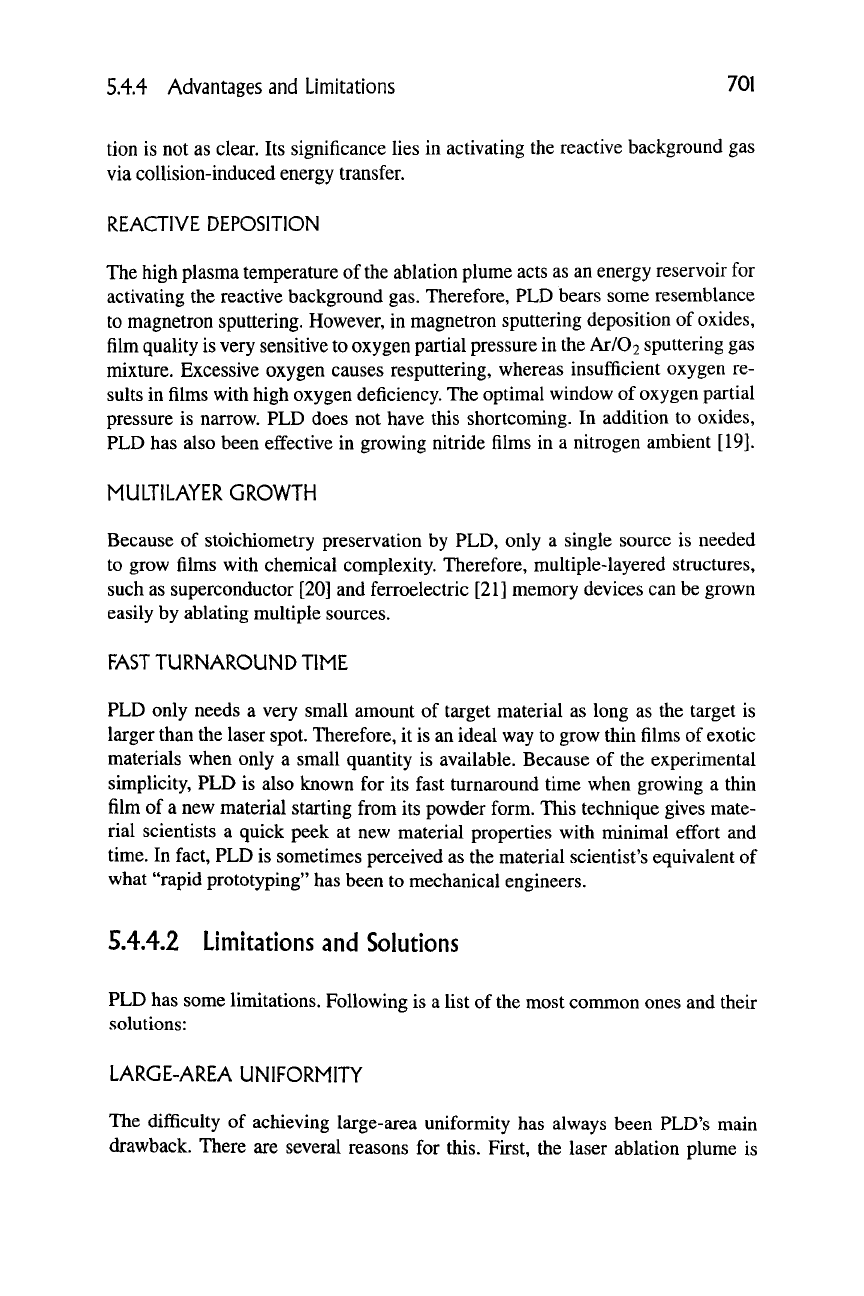
5.4.4 Advantages and Limitations 701
tion is not as clear. Its signiiacance lies in activating the reactive background gas
via collision-induced energy transfer.
REACTIVE DEPOSITION
The high plasma temperature of the ablation plume acts as an energy reservoir for
activating the reactive background gas. Therefore, PLD bears some resemblance
to magnetron sputtering. However, in magnetron sputtering deposition of oxides,
film quality is very sensitive to oxygen partial pressure in the Ar/02 sputtering gas
mixture. Excessive oxygen causes resputtering, whereas insufficient oxygen re-
sults in films with high oxygen deficiency. The optimal window of oxygen partial
pressure is narrow. PLD does not have this shortcoming. In addition to oxides,
PLD has also been effective in growing nitride films in a nitrogen ambient [19].
MULTILAYER GROWTH
Because of stoichiometry preservation by PLD, only a single source is needed
to grow films with chemical complexity. Therefore, multiple-layered structures,
such as superconductor [20] and ferroelectric [21] memory devices can be grown
easily by ablating multiple sources.
FAST TURNAROUND TIME
PLD only needs a very small amount of target material as long as the target is
larger than the laser spot. Therefore, it is an ideal way to grow thin films of exotic
materials when only a small quantity is available. Because of the experimental
simplicity, PLD is also known for its fast turnaround time when growing a thin
film of a new material starting from its powder form. This technique gives mate-
rial scientists a quick peek at new material properties with minimal effort and
time.
In fact, PLD is sometimes perceived as the material scientist's equivalent of
what "rapid prototyping" has been to mechanical engineers.
5.4.4.2 Limitations and Solutions
PLD has some limitations. Following is a list of the most common ones and their
solutions:
LARGE-AREA UNIFORMITY
The difficulty of achieving large-area uniformity has always been PLD's main
drawback. There are several reasons for this. First, the laser ablation plume is

702 Chapter 5.4: Pulsed Laser Deposition
non-Lambertian. Its spatial profile follows a (cos^)" distribution where the expo-
nent n varies from n = 3 to /i = 11 and higher. In addition to the narrow angular
profile of the plume, separation between the target and substrate is only a few
centimeters in order to take full advantage of the laser-induced plasma. Both lim-
itations pose severe problems in scaling up to large area.
There have been many attempts to meet this challenge. Solutions include an
off-center substrate mount, an off-axis substrate mount, and a rastering laser spot
over a large target [22]. Verdicts are still out to decide as which approach is the
most practical and appealling.
ROUGH SURFACE MORPHOLOGY DUE TO "SPLASHING"
A major concern of PLD is the presence of micron-size particles on deposited films
due to "splashing," which is the consequence of intense laser-target interaction.
There are three major causes of splashing.
1.
Exfoliation. During laser ablation, materials are removed in a preferential
orientation along the direction of the incident laser beam. The departed material
leaves deep channels and thin columns on the surface. Such microstructures are
mechanically weak and are easily broken by thermal shocks [23]. Debris lands on
the substrate surface, resulting in rough morphology. The signature of this type of
splashing is the appearance of irregular-shaped micron-sized particles.
2.
Subsurface boiling. Subsurface boiling was originally referred to as "true
splashing" by Ready [24]. It occurs if the time required to transfer laser energy
into heat is shorter than the time to evaporate a surface layer with a thickness on
the order of absorption depth. Under this condition, the subsurface layer is super-
heated before the surface material is completely vaporized. Boiling subsurface
material explodes from the surface and ejects micron-size molten globules. Tour-
tellote [6] estimated a threshold power density for subsurface boiling of a metal-
lic target to be 5 X 10^ W/cm^ and higher for dielectric materials. This power
density range is higher than typically found in PLD. Therefore, subsurface boil-
ing has a negligible significance except for a few materials containing very vola-
tile constituents such as Hgi_xCdxTe (high Hg pressure) [25].
3.
Shock-Wave-Induced Droplet Expulsion. Unlike subsurface boiling, in which
the force that expels liquid droplets comes from within the bulk, shock-wave-
induced droplet expulsion is caused by the recoil pressure exerted by the shock
wave of the departing plume. The signature of this type of splashing is also con-
densed molten globules, similar to subsurface boiling, but much smaller, typically
in the submicron range. In contrast to subsurface boiling, the threshold power
density for this mechanism to occur is low, nearly as low as the ablation thresh-
old. Therefore, there is little chance of eliminating it completely. For some com-
pounds, such as CdTe, ZnTe, and ZnSe, PLD-grown films are smooth without any

5.4.4 Advantages and Limitations
703
trace of splashing. This is consistent with the recoil pressure/surface melt inter-
action model, because these materials do not have a melt phase. The vaporization
of these materials is dominated by sublimation.
SOLUTIONS TO AVOID SPLASHING
Since the inception of PLD, there has been a continuous struggle to eliminate
splashing. Many experiments have been attempted. Some of them can be consid-
ered as the brute force approach, while the others rely on more subtle principles.
Here, we only list the most conmion remedies to this problem.
1.
Target Surface Conditioning. The use of dense targets, mechanically pol-
ished surface, or ablation with low-fluence laser pulses prior to film growth can
reduce exfoliation.
2.
Particle Filter. The particle filter approach relies on the fact that particles in
the ablation plume travel much more slowly (about 10'^ cm/sec) than atomic and
molecular species (10^ cm/sec and higher). Particles can therefore be removed by
a synchronous mechanical shutter
[26],
rotary vane filter [27] (shown in Figure 4),
or multiple-disk velocity filter [28]. These methods are effective in removing par-
Fig.
4.
Substrate
(zz:
C2
Laser beam
A rotary vane particle
filter
[27].
